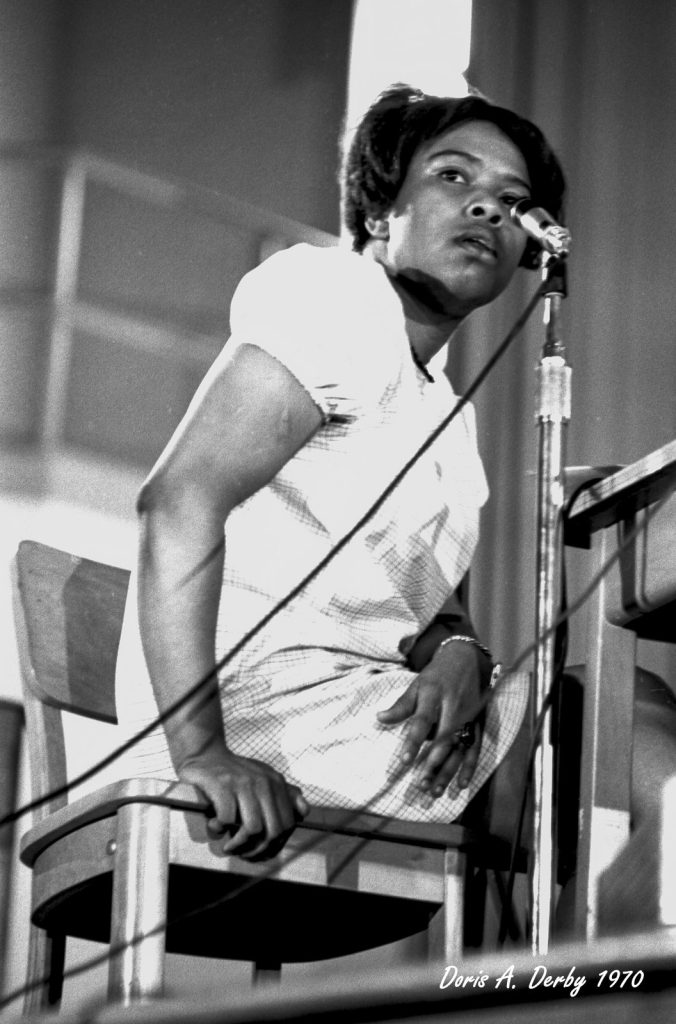
(Tuscaloosa, Ala.) — The Paul R. Jones Museum is pleased to present an exhibition of photographs, May 1970: The Gibbs-Green Tragedy at Jackson State College, from August 4 to September 29, 2023. There will be a reception on Friday, September 1, from 5:00 to 8:00 p.m., during downtown Tuscaloosa’s First Friday Art Walk.
May 1970: The Gibbs-Green Tragedy at Jackson State College is a documentary exhibition of photographs taken by civil rights activist Doris Derby in the days and weeks immediately following the killing of Phillip Gibbs and James Earl Green during police shootings on Jackson State campus on the night of May 14, 1970. The exhibition is organized and sponsored by the Margaret Walker Center at Jackson State University in Jackson, Mississippi.
Earlier in May 1970, Jackson State students had staged a series of protests over their treatment at the hands of white motorists speeding through campus on John R. Lynch Street. Those white drivers were notorious for shouting racial epithets, throwing things from their cars, accelerating toward students crossing the street, and hitting at least one student.
On the night of May 14, 1970, a large dump truck was set on fire by an unknown person in the middle of John R. Lynch Street, and Jackson city police and Mississippi highway patrolmen responded in full riot gear near midnight, although no students were protesting on campus. The police and highway patrol turned on Alexander Hall, a women’s dormitory. They later claimed that a sniper had fired on them from the 4th floor, a claim fully debunked. From eyewitness accounts, a student threw a bottle at the police, and, when it broke, they opened fire, spraying nearly 400 rounds of bullets and buckshot over 28 seconds in every direction. When the firing ceased, two young men lay dead: Phillip Gibbs, a junior political science major who was married with two children, and James Earl Green, a senior at nearby Jim Hill High School who was walking home from work on the opposite side of the street. Twelve people were shot by the police and survived, while dozens more were injured by the exploding glass and brick. Hundreds of witnesses bear the psychological scars of that night, which spilled into the early morning of May 15, 1970. No one was ever charged for the murders of Phillip Gibbs and James Earl Green.
Doris Derby (1939-2022) was a civil rights activist and documentary photographer who served as a field secretary for the Student Nonviolent Coordinating Committee (SNCC) from 1963 to 1972, working with multiple grassroots organizations in the Jackson, Mississippi, area. From 1968, she also worked on the staff of the Institute for the Study of the History, Life, and Culture of Black People, founded by the writer and scholar Margaret Walker at then Jackson State College. After the attack on the women’s dorm at Jackson State by the police and the killings of Gibbs and Green, Derby began photographing the related events and people in order to document as much as possible of what was happening. From more than 400 negatives, she selected sixty images for the exhibition first shown at Jackson State in 2021.
In 2015, a separate exhibition of Doris Derby’s works was shown at The University of Alabama Gallery. Curator Emily Bibb remembers, “I was lucky enough to meet Dr. Derby. Her works demonstrated the grace and respect with which she photographed working people and their fight for equal rights. Dr. Derby also generously donated one of her photographs, Mrs. Fannie Lou Hamer at the Mississippi Democratic Nominating Convention, Masonic Temple, Jackson, Mississippi, 1968, to the Paul R. Jones Collection of American Art at The University of Alabama. When museum director Daniel White suggested we host this exhibition that documents the mourning and reconciliation process after the Gibbs-Green tragedy at Jackson State, I knew that Dr. Derby’s photographs would not only show the events of the time, but also the complicated emotions in play in the Jackson State community dealing with those events. While this tragedy took place more than 50 years ago, I think viewers will find the topic unfortunately relevant.”
Doris Derby went on to earn a BA from Hunter College and a PhD from the University of Illinois. She taught anthropology at Georgia State University and was the founding and longtime director of the African American Student Services and Programs at GSU. Derby was the recipient of several awards including the Georgia Humanities Award in 2011 and the For My People Award from the Margaret Walker Center in 2021. Her photographs have been exhibited in the US and the UK including the Mississippi Civil Rights Museum (Jackson), National Museum of African American History and Culture (Washington, D.C.), Field Museum (Chicago), The Bronx Museum (New York), Skirball Cultural Center (Los Angeles), High Museum of Art (Atlanta), Krannert Art Museum at the University of Illinois, Rose Library at Emory University, and The Art Gallery at Jackson State University.
This exhibition is organized and sponsored by the Margaret Walker Center at Jackson State University in Jackson, Mississippi, with support from the Gibbs-Green Commemoration Commission, the Mississippi Humanities Council, and the Jackson State University Department of Art.
The Paul R. Jones Museum is an essential part of the education and development of UA students and our community. Admission to the museum is free. The museum is located at 2308 Sixth Street, in downtown Tuscaloosa, one block from the Dinah Washington Cultural Arts Center. Hours are Monday-Friday, 9 a.m. to 5 p.m., and First Fridays 12 noon-8 pm. Have questions or need assistance? Call (205) 345-3038 or go to their website.
For more information about The University of Alabama’s programs in studio art and art history, visit our Degree Programs page.